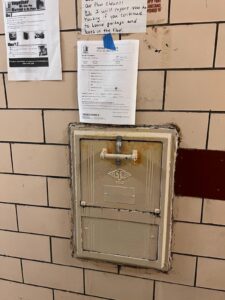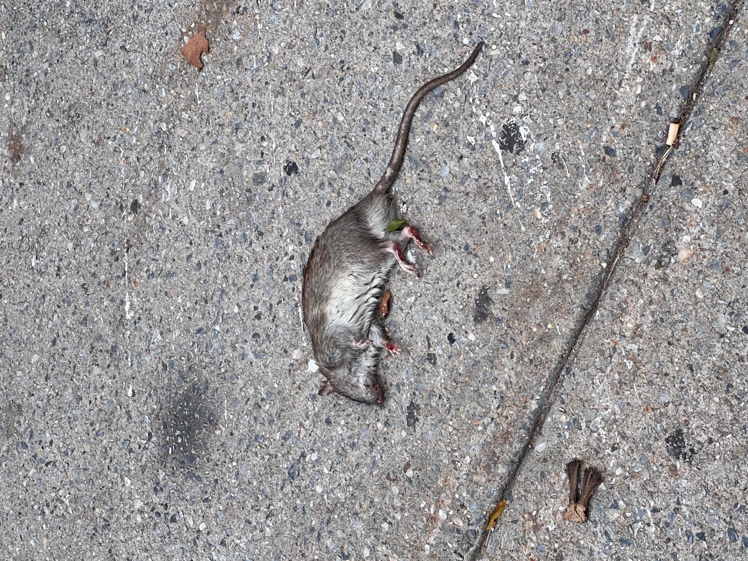One evening outside Mitchel Houses, Donna Jackson walked up a ramp with her walker when she saw a familiar terrifying creature – a rat — huddled in a corner. It ran in her direction.
She dashed to the bottom of the ramp rushing in her walker when she heard something crack under the wheels. It was Jackson’s toe. Three weeks later, Jackson’s toe is still wrapped in bandages.
“Some kids came outside. They told me to calm down and stop running, but I was too petrified,” said Jackson, whose bandaged toes exposed a small red spot of blood. The doctor said it would take the next few weeks to heal.
Jackson is one of 4,000 residents living in Mitchel Houses, where rats reportedly run rampant.
According to 311 complaint data from the Mitchel Houses, Port Morris zip code (10454), there was a 19% increase in rat sightings from 2017 to 2021 and a 95% jump in complaints from 2020 to 2021.
Rat 311 complaints in 10454 zipcode
Borough-by-borough comparison for 311 rodent complaints
The 311 data shows that the number of rat complaints in the Bronx shot up to 30,500 in the beginning of 2021, the highest of the five boroughs. So far in 2022 the Bronx has racked up 23,000 rat complaints. In Brooklyn, there are 28,000; Manhattan, 13,000; Queens, 9,000; Staten Island, 2,000.
Ramona Ferreyra, who lives at Mitchel and regularly organizes her fellow residents to speak out on problems in their buildings, says the rodent problem is a big one. “My dog’s friend was chasing a rat and got his face bitten off. Now I stay worried about my pet’s safety.”
Residents have to be careful to avoid getting bitten. Bites and scratches can lead to rat bite fever, which can be fatal.
According to Ferreyra, garbage lying outside serves as an open invitation for rats and other vermin. Huge trash bins are placed outside each building at Mitchel, but the majority of them don’t have lids. Ferreyra said that when the trash overflows and starts to reek, rats jump out of their burrows, follow the smell, and enter the buildings.
Ferreyra said that she kept filling out work tickets to NYCHA to exterminate the rats. The organization put rat poison in public spaces. According to Jackson and Ferreyra, the rat problem persists, despite NYCHA’s efforts.
Public health concerns
Rats pose serious health concerns for the New Yorkers. The diseases they carry are wide-ranging, and can spread via contaminated air, direct contact, and other means. At a June 2022 City Council hearing, one council member pointed out that 13 New Yorkers were hospitalized last year due to a kidney and liver disease spread by rats.
One disease associated with rats is asthma. According to the National Library of Medicine, Bronx children are twice as likely to be hospitalized for asthma as other American children.
Constant exposure to pests and dander can contribute to asthma. In 2019, the Asthma-Free Housing Act went into effect, requiring New York City landlords to keep their buildings free of asthma-inducing factors like rodents.
Finally, she got in touch with City Councilwoman Diana Ayala, who funded four trash cans for each building. Mitchel continues to face the same issues of improper waste management.
In an attempt to solve the problem, Ferreyra contacted Rat Trap Distribution, a company that offers preventive pest and rodent control solutions against infestation.
“The place was overcome with rats,” said Pat Marino, the founder of Rat Trap Distribution, who responded to Ferreyra’s call. He noticed at least 70 burrows where rodents roamed around in the daytime when he visited Mitchel Houses.
“I said, I do not need to look at the rest of these buildings. You're going to need 25 [of my rat trap devices] just on the parameters because they are all big buildings,” Marino said.
Marino believes that when restaurants shut down during Covid, rats lost their food source and migrated to the “private sector” – residential areas -- to find food. This could explain the increase in rat sightings, said Marino, who charges $250 per rat trap.
Ferreyra and some senior residents raised $800 for the traps but fell short. They approached the City Council and the borough president’s office for funding, but the pandemic put a halt to their talks.
A member of the Tenant Association at Mitchel, Elena Ramos, lives on the fifth floor of her building. Her building’s trash compactor has been locked for the past month because rats have found a way inside it. So the building staff sealed the trash chutes on every floor. Ramos also frequently sees rats running in the hallways of her building.
“Mickey Mouse doesn’t pay the rent to stay here. We do. They gotta go,” said Ramos.
Ramos’ mother, Elena Farciert, who has lived at Mitchel for over three decades, said, “I love my apartment. I love my neighborhood, but sometimes it’s difficult to live here.”

A sealed trash compactor at Mitchel Houses, underneath a handwritten note advising tenants against leaving trash on the floor.
First-floor resident Embraia Fraizer said the rats will disappear “when people stop throwing their garbage out the window.” She has seen rats climb up scaffolding and people running from rats.
At Jackson Houses in Melrose, Danny Barber, executive board chair of the Citywide Council of (NYCHA) Presidents called Mitchel Houses a “buffet for rats,” due to poor sanitation. Echoing Ramos’ point, he said that while residents do play a part in trash disposal, NYCHA is also understaffed and is unable to get rid of the rats.
Meanwhile, City Council members announced a ‘Rat Action Plan’ in July to address the citywide infestation. This summer, the City Council allocated $4.8 million for rat control in the new budget. The plan named zones prone to a rat infestation and require rodent-proof trash bins, among other things. The Sanitation Committee will put the plan into action and periodically report the progress to the City Council.
Rochel Leah Goldblatt, a NYCHA spokesperson, said the housing authority is actively working to tame the rat issues at Mitchel.
"NYCHA is committed to ensuring our buildings and grounds are clean and as pest-free as possible,’’ she said, adding that Mitchel Houses has been treated for rats 167 times since May and the last significant treatment of the grounds was in September.
NYCHA’s approach to treatment is called integrated pest management (IPM). Goldblatt said this involves using tracking powder and first strike, both rodenticides; collapsing rat burrows, which NYCHA does twice a month at Mitchel; and putting wire lath in the ground to prevent rats from burrowing.
In addition to extermination measures, NYCHA claims their pest management team seals window wells, scrubs compactors, power washes concrete slabs where trash is left, and picks up dead rats and droppings.
According to Goldblatt, NYCHA plans to dedicate $619 million in funding over the next six years to improve waste management and pest control at 324 sites across their 197 developments.
One NYCHA resident said she’s seen people putting rat poison down in the grass around the trees and against the walls of the buildings but isn’t sure if it’s NYCHA. Regardless, she doesn’t think the problem is getting better.
Neither does Jackson. Six weeks later, her toe has still not healed.

